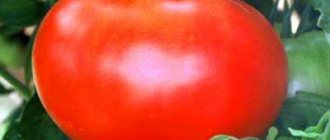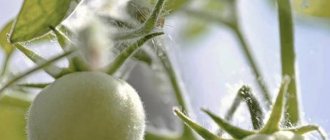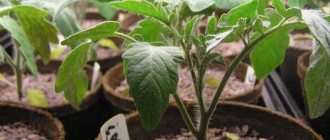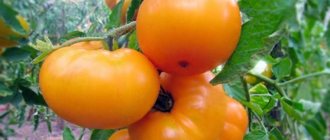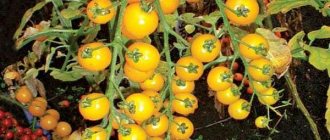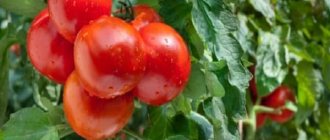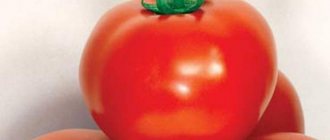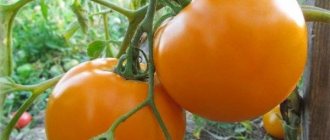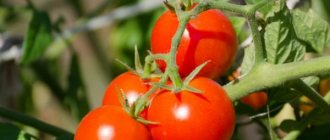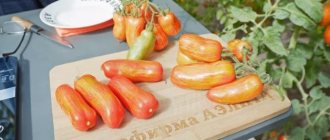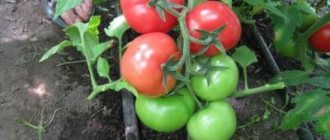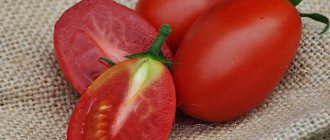With its beautiful and abundant harvests, the Santa Claus tomato brings no less joy to farmers than the approaching Christmas. Tomato superbonuses - excellent taste and product characteristics, simple agricultural technology, disease resistance.
| Height | Landing location | Ripening time | Fruit color | Fruit size | Origin | Fruit shape |
| Tall | Greenhouse, Open ground | Mid-early | Reds | Average | Variety | Flat-round |
Growing tomatoes
The traditional way of cultivating the tomato variety “Alenka” is to plant seedlings.
How to prepare seeds?
Preparatory activities are mandatory. Selected high-quality seeds are placed in a manganese solution for 15-20 minutes for disinfection. Then washed and dried. Treatment with a growth stimulant will also be required. Aloe juice can serve as an analogue of a growth stimulator.
Sowing seed material
Description:
- Seeds are sown for seedlings mainly in early March. This will allow the seedlings to get stronger by the time they are planted in a permanent place;
- Until the sprouts appear, the required temperature regime is not lower than +22 degrees, then maintain the temperature from +15 to +17 degrees for a week. Then it is raised again to room temperature;
- In order for seedlings to grow and develop normally, additional lighting will be required. Fluorescent lamps are ideal as an additional source of lighting;
- At the stage of formation of the first pair of full-fledged leaves, seedlings are planted in separate peat containers;
- To facilitate the adaptation period after transplanting to a new location, within a week before the transplant date, the seedlings are taken out into the open air for hardening.
Rules for planting seedlings
Description:
- Seedlings are planted in open ground only after the end of the cold weather, in sufficiently warmed soil. Specific dates are mostly determined by the climatic conditions of the growing region and vary from mid-May to mid-June;
- It is advisable to plant tomato bushes in cloudy weather or in the evening;
- Be sure to follow the recommended planting pattern - 40x60 cm. No more than 5 tomato bushes are planted per 1 m2.
Growing
The seeds are sown two months before transferring the plants to open ground. Before planting, all seeds are soaked for 10 - 15 minutes in a weak solution of manganese, and then for several hours in a solution of a growth stimulator. Next, the seeds are placed in soil with sand, peat, ash, manure and humus. You can also purchase soil for vegetable crops at a specialty store. After the container is covered with film or glass. When all the seeds have hatched, the containers should be moved to a consecrated place and additional lighting should be used in the form of a fluorescent lamp. If this is not done, the shoots will become very elongated and will hurt for a long time after transplanting into the soil.
When the second true leaf appears, the plant is pruned. Transfer each tomato to a separate peat pot or other container. All bushes are watered 1-2 times a week. Seedlings should be watered moderately without flooding the root system.
When transferring tomatoes into the ground, it is better to plant the plants on a sunny, windless side or in greenhouses. For more productive cultivation, 3 to 5 sprouts are planted per 1 m2. Sometimes, for a good harvest, two plants are placed in one hole at once. Ripening is simultaneous if all the tomatoes are planted at the same time.
During the growth of the tomato, the stepsons should be removed. It is also necessary to tie up the stems and fruits. Timely application of mineral fertilizers containing nitrogen, phosphorus and potassium is the key to a good ripe and juicy harvest. Feeding should be carried out no more than three times per season.
Watering is carried out as needed. After irrigating the soil, it needs to be loosened. It is important to carry out timely weeding so that the earth breathes and the root system of weeds does not become intertwined with the tomato.
tomato Sugar mouth - description and characteristics of the variety
Description of the Santa Claus tomato and growing in open ground
The Santa Claus tomato was included in the Russian state register in 2014. It is recommended to grow it on personal farmsteads and garden plots in greenhouse blocks or in open ground. It is possible to grow this tomato for seeds so that in a year you can germinate seedlings from your own harvest.
Briefly about the plant and its fruits
The characteristics and description of the Santa Claus variety are as follows:
- The harvest after planting seeds for seedlings occurs within 100 days. If a gardener uses already grown seedlings, the harvest can be obtained in 30-35 days.
- Bushes of this variety in open ground grow up to 90-100 cm in height, and when cultivating tomatoes in a greenhouse - 180-200 cm.
- The bushes have an average number of leaves, colored in dark shades of green.
- On 1 bush, from 10 to 12 clusters are most often formed, each of which produces 5-6 berries. Reviews from gardeners show that to get a good harvest it is necessary to remove the shoots from the stems. Due to its great height, the bush must be tied to trellises or supports. If this is not done, then under the weight of the berries, the branches of the plants may sink to the ground or break.
- The weight of a ripe fruit ranges from 100 to 150 g. The berries are colored in bright shades of red. If there were bad weather conditions during the ripening of the tomato, then a pale spot appears on some fruits in the stalk area.
- The shape of the berries resembles a smooth sphere without signs of ribbing. From 2 to 4 seed chambers are formed in the fruit pulp.
Farmers who cultivate this tomato indicate that its yield is quite high, since from 6.0 to 10 kg of fruit can be obtained from a bush. These tomatoes are used fresh, made into juices, tomato paste, and pickled for the winter. In Russia, Santa grows well in open ground in the southern regions. When cultivating this tomato in the central zone of the country and in the Siberian expanses, it is recommended to use film greenhouses and greenhouse blocks.
How to grow the Santa Claus variety yourself?
It is recommended to pre-treat the seeds with a weak solution of potassium permanganate for 15-20 minutes. After this, they are placed in boxes containing special soil for tomatoes, mixed with sand and peat. The seeds are buried 15-20 mm and watered with warm water. After the sprouts germinate a week later, it is recommended to add a small amount of organic fertilizer to the soil. If necessary, growth stimulants are used to germinate seeds.
Seedlings sprout after they develop 1-2 leaves. Plant boxes should be installed in a well-lit area. For young tomatoes, 16 to 18 hours of daylight should be maintained.
When the seedlings are 60 days old, they are transplanted into pre-loosened soil in a greenhouse. Nitrogen fertilizers are pre-introduced into the soil. Seedlings should be planted in beds well lit by the sun. From 3 to 5 seedlings are planted per 1 m².
If the planting site is chosen correctly and there are no drafts (when grown in a greenhouse) or wind (in open ground), then fruit ripening occurs almost simultaneously. It is recommended to loosen and hill up the beds in a timely manner, otherwise half the harvest may be lost. Watering the bushes is done in the early morning 1-2 times a week.
To obtain maximum yield, it is recommended to remove all stepsons. Tomatoes are fed with mineral fertilizers 3 times per season. The gardener must inspect the bushes every day in order to notice in time the appearance of rot, fungal infection, and drying out.
To prevent diseases, before planting seedlings in the ground, water the soil with a solution of potassium permanganate and add ash. It is recommended to immediately destroy (burn) a bush infected with late blight. Various chemicals can be used to combat the disease.
If insects appear on the bushes that can destroy the crop, for example, the Colorado potato beetle, aphids, then they need to be eliminated using chemicals.
Description of the Santa Claus tomato variety, cultivation and care for it
The Santa varietal tomato appeared on Russian markets relatively recently. It was included in the state register of plants in 2014 for cultivation in greenhouses and open ground. Many amateur gardeners have already tried the variety in their garden beds and respond positively. This tomato can be grown for seeds and seedlings from your own harvest can be planted next year.
Characteristics of the variety
Determinate tall tomato variety Santa Claus, intended for cultivation in open and closed ground. An adult plant reaches a height of 1 meter, individual individuals grown in a greenhouse - up to 2 meters. The ripening period from planting is 100 days. When grown by seedlings, it takes 30 days from planting the seedlings in the ground to receiving the harvest.
Leaves are medium in number, dark green in color. Up to 12 cluster ovaries with 5–6 tomatoes on each are formed on the bush. Although the plant is determinate, it still requires pinching and staking. Otherwise, the bushes will lie on the ground under the weight of the fruits.
Description of the fruits - when ripe they reach a weight of 150 grams. Bright red in color, on some tomatoes a pale spot forms at the stalk in bad weather conditions. Tomatoes have a round, even shape without ribbing. The taste is sweet, tomato, without acid. 4 chambers with seeds are formed in the fruit.
The yield is high - 6–10 kilograms of fruit are harvested from one bush. In this case, from 3 to 5 plants are planted per square. Maturation is friendly.
A variety of universal use, consumed fresh, prepared in sauces, juices, pickled.
Agricultural technology
The seeds of the variety are planted for seedlings 2 months before transplanting into the ground. It is grown mainly by seedlings. To speed up seed germination, growth stimulants are used. It is important to plant the seedlings in a sunny, not windy place in the garden so that the fruits ripen evenly.
After planting in the main place of growth, it is recommended to shoot and tie up the tomatoes. Responds well to fertilizing with mineral fertilizers. Some gardeners plant two bushes in one hole to obtain a double harvest.
Plant care
The varietal characteristics are such that with proper care of the plants, the fruits ripen together and delight their gardeners with a bountiful harvest. How to care for tomatoes:
- Plants are watered as needed.
- After watering, it is advisable to loosen the soil around the stems.
- Weeding is an important condition for good growth of tomatoes.
- The bushes are tied up and pinched so that they do not break under the weight of the fruits and the growth does not turn into a green mass.
- Feed plants and soil at least three times per season. Thus, tomatoes have enough nutrients to ripen the fruit.
- You need to constantly inspect the green mass for the presence of rot, fungi and drying out.
Disease Prevention
Tomato diseases develop so quickly that they can destroy the entire crop in a week. To prevent diseases, diseased seedlings should not be planted with healthy plants. You need to water the bushes at the root. Water that gets on the leaves will cause late blight in tomatoes, a very dangerous disease.
Before planting, the soil is sprinkled with wood ash and watered with a warm solution of potassium permanganate. The solution destroys bacteria and fungi in the soil, thereby protecting plants from further infection. If an infected bush is discovered, it is immediately removed from the site and destroyed by burning. Infected plants left to humus will transmit the fungus into the soil, and the fungus will spread everywhere when the area is dug up.
Variety success
Tomatoes of the Slavic masterpiece variety are quite resistant to various diseases. The strong peel of the fruit makes tomatoes suitable for long-term storage and for transportation over long distances without losing their presentation. Gardeners note the long duration of fruiting, which is a clear advantage of the crop. The fruits have standard sizes, as a result of which they are excellently used for all types of preparations. Tomatoes are used to prepare paste, sauces, ketchups, and canned whole or in halves. If you follow all the rules for growing the Slavic Masterpiece variety, it is not prohibited to obtain excellent quality fruits and a rich harvest.
Application
Tomato "Santa Claus" is very tasty when used fresh. Salads are made from it. Suitable for making sauces, ketchups and juices. Used in pickling. Combines with stewed and baked meat. It will add softness to the meat when marinating shish kebab. Suitable for preparing vegetable caviar and lecho.
The Santa Claus tomato with this New Year's name will appeal to both professionals and amateurs for its productivity, tasty and neat fruits, which are suitable for preparing a large number of dishes and marinades.
Description of the tomato variety Swat f1, its characteristics and yield
Swat tomatoes are among the most delicious tomatoes. They are distinguished by a stately, powerful bush, on which beautiful fruits of an even, round shape hang solidly. The variety is universal, undemanding in care, stress-resistant, suitable for growing in any conditions.
Description of the variety
The plants are characterized by pink, smooth, fleshy and very juicy fruits, the weight of which sometimes reaches 800 g.
- seed class: 1 class;
- variety type: early, interdeterminate;
- purpose: universal;
- height: 0.7 m in open ground, up to 1.2 m in a greenhouse;
- fruits: round, red-scarlet in color;
- weight: 90–160 g.
The plants have a good balanced taste. The description of the variety states that tomatoes can be grown for salads and canning.
Planting
When planting, it is necessary to adhere to hygiene rules, since the description of the Swat f1 tomato indicates that infection can reach the seeds through insufficiently carefully treated containers. It is also preferable to perform all work with gloves or wash your hands periodically.
Seeds for seedlings are planted between March 15–20 and March 30. No more than 60 days should pass before planting and before planting in the ground. Charcoal drainage and well-mixed seedling soil are poured into the container. Then the soil is moistened and holes 1 cm deep are made in it, at a distance of 3 cm from each other.
After the seeds are planted, they are covered with dry soil on top and removed to a warm place. The room temperature should be 28–30 °C.
Maintaining the temperature regime is extremely important, otherwise the seeds will rot or take a long time to germinate. When the first shoots appear, the temperature drops to 15–18 °C during the day and 10–12 °C at night
After a week, the temperature rises again to 20–25 °C during the day, and 12–15 °C at night
When the first shoots appear, the temperature drops to 15–18 °C during the day and 10–12 °C at night. After a week, the temperature rises again to 20–25 °C during the day, and 12–15 °C at night.
Disease Prevention
Tomato diseases develop so quickly that they can destroy the entire crop in a week. To prevent diseases, diseased seedlings should not be planted with healthy plants. You need to water the bushes at the root. Water that gets on the leaves will cause late blight in tomatoes, a very dangerous disease.
Before planting, the soil is sprinkled with wood ash and watered with a warm solution of potassium permanganate. The solution destroys bacteria and fungi in the soil, thereby protecting plants from further infection. If an infected bush is discovered, it is immediately removed from the site and destroyed by burning. Infected plants left to humus will transmit the fungus into the soil, and the fungus will spread everywhere when the area is dug up.
How to grow tomatoes
The seedlings are ready for planting in a permanent place in 50 - 55 days. Fertilizers such as humus, compost or peat are first added to the soil.
Tomatoes need to be planted in two rows, with the seedlings of the first row in relation to the seedlings of the second row placed in a checkerboard pattern. The distance between bushes is at least 50 cm, and between rows - 40 cm.
Watering is most important during the flowering and fruit set stages. Without a sufficient amount of moisture, pollination will not occur, and those fruits that have time to set will not gain weight. Water tomatoes at the root, which prevents fungal diseases.
Water 2 times a week in the evening, 2 liters of water for each seedling. A good conductor of water is an ordinary plastic bottle without a bottom. It is installed at a shallow depth in the root zone and filled with water, which gradually penetrates to the roots.
After watering, weeding and loosening of the soil is necessary. These simple steps not only provide oxygen access to the roots, but also help in pest control.
Mulching beds with straw is another preventive measure that keeps beds moist longer.
A determinate plant requires obligatory garter, since heavy fruits can break not very powerful stems. Vertically stretched ropes or wooden stakes serve as a strong support.
In addition to the garter, mandatory stepsoning is required.
Pinching involves removing additional stems that appear in the axils between the main trunk and the tomato leaf. In one season there are up to 50 stepsons on a plant. If they are not removed, then the excess of branches will not allow the fruits to gain the proper weight.
Vegetables planted in street beds are grown in 3-4 fruit stems, and in a greenhouse - in 1 stem. Growing in a greenhouse involves dense planting and tying to a rope support.
The formation (stepchildren) of a culture depends on the region in which it grows. In the northern regions, the best fruiting rate is observed when growing in 2 trunks, in the southern regions - when growing in 3-4 trunks.
To limit plant growth, pinch the top.
To achieve maximum fruiting, they resort to specialized preparations. For example, boric or succinic acid increases the number of ovaries in each cluster, and growth stimulants (Biostin, Rhizome) help to quickly gain root mass.
Diseases and pests
Despite its Siberian character, the plant is susceptible to diseases such as late blight, verticillium wilt, and blossom end rot.
Fungicidal agents help in the fight against these diseases.
Calcium nitrate successfully combats blossom-end rot by watering and spraying the plant.
In the fight against late blight, the main role is given to Bordeaux mixture or Fitosporin. These drugs destroy the cause of the infection, and the affected parts of the plant should be burned. Copper sulfate is used as a preventive measure against late blight.
As for insects, they are not averse to taking over vegetable beds and causing considerable harm to plants. These are known to every summer resident: mole crickets, spider mites, gnawing cutworms, Colorado potato beetles, and slugs.
Beds covered with wood ash and tobacco dust save tomatoes from pests, as does regular inspection of the bushes.
Slugs and Colorado potato beetles are collected by hand, and mole crickets are scared away from the beds by pungent odors.
Spider mites live in a greenhouse, so there is a need for regular ventilation in order to destroy the conditions for the existence of the parasite.
Insecticides also help protect against parasitic insects. But remember that treatment with them is possible 1 month before fruiting.
Diseases
It is important to monitor disease prevention in a timely manner. Unfortunately, some fungal infections can harm not only the bushes in a week, but also destroy the entire crop.
- When watering, it is important to irrigate the soil at the root level. Do not use a spray bottle. You need to make sure that water does not get on the tomato leaves. Otherwise, the plant may get late blight.
- Before transferring the tomato into the ground, sprinkle the hole with ash. It helps protect the root system from the proliferation of many diseases. You can also add ash to the soil throughout growth to prevent disease.
- Before planting plants in the ground, you can spill the entire soil with a solution of potassium permanganate. This manipulation will help disinfect the soil from many bacteria, as well as a number of pests.
- If an infected plant is discovered during growth, it should be removed so that the disease does not affect healthy bushes. Under no circumstances should such plants be composted; they should be burned.
- To prevent pests from attacking tomatoes, the bushes are fumigated with smoke. A fire is built near the plants using plenty of leaves or grass. You can use a smoke bomb. This procedure will help get rid of some insects and their larvae.
Planting in a greenhouse
Good and high-quality seedlings - strong, not overgrown, with 8-9 true leaves. When planting, follow the scheme: two plants per square meter.
The holes are shed with warm water, the seedlings are carefully planted, and sprinkled with earth. It is advisable to choose a cloudy day for planting or transplant tomato seedlings in the late afternoon.
Temperature in the greenhouse: +20ºC…+25ºC, at night – not lower than +18ºC. It is also necessary to observe air humidity indicators - 55-65%, since dry air is also harmful to tomatoes, as is high humidity.
ON A NOTE! A greenhouse with tomatoes must be ventilated (vents, windows, doors), especially in hot and rainy weather.
The presence of shade in the greenhouse is not allowed; tomatoes should receive as much light and solar heat as possible. Aventyuniai loves warmth and light, and high yields cannot be obtained if the plants are shaded.
Caring for Djalo Santa tomatoes
After the plant is placed in the ground, first of all, it should be thoroughly watered with warm water. Moisture is the main nutrition of tomatoes, but this is not a reason to over-water the soil. Tomatoes do not tolerate swampy substrates, so irrigation should be moderate, as the earthen clod dries, but does not dry out. Otherwise, excess moisture causes fungal diseases.
Tomatoes are useful not only as a source of vitamins and minerals. They are rich in lycopene, antioxidants and carotene. Golden Djalo Santa, when consumed during the summer, can improve vision and strengthen the body.
| Height | Landing location | Ripening time | Fruit color | Fruit size | Origin | Fruit shape |
| short | Greenhouse, Open ground | Mid-season | Yellow | Average | Variety | Flat-round |
Plant care
The varietal characteristics are such that with proper care of the plants, the fruits ripen together and delight their gardeners with a bountiful harvest. How to care for tomatoes:
- Plants are watered as needed.
- After watering, it is advisable to loosen the soil around the stems.
- Weeding is an important condition for good growth of tomatoes.
- The bushes are tied up and pinched so that they do not break under the weight of the fruits and the growth does not turn into a green mass.
- Feed plants and soil at least three times per season. Thus, tomatoes have enough nutrients to ripen the fruit.
- You need to constantly inspect the green mass for the presence of rot, fungi and drying out.
Large-fruited Dutch hybrids for greenhouses
Among the new hybrids, all large-fruited varieties turned out to be intended for the Central Black Earth growing zone. They have a number of common characteristics: they are recommended for spring and summer rotations. Plants are indeterminate. They can be safely classified as the best varieties of Dutch tomatoes for greenhouses due to their excellent yield.
Belfast F1
The yield of the hybrid was 26.2 kg/m2. A salad variety, early ripening with round, multi-chambered, slightly ribbed, red fruits. The fruit density is average, weight 208 g. The taste is rated as good.
Dimerose F1
A mid-early hybrid for salad purposes, it produces pink multi-chambered fruits of excellent taste. The fruits are hard, round, weighing 196 g. The marketable yield averaged 27.2 kg/m2.
Pozzano F1
A mid-early hybrid of universal use, can be used for whole-fruit canning. Tomatoes are cylindrical in shape. The pulp is firm, 3-chambered. The weight of red tomatoes is 180 g, the taste is excellent. The total yield is 25.4 kg/m2, the early one was 9.5 kg/m2.
Russians liked Dutch hybrids for their stability and stable yield. New varieties can successfully compete with those already loved and significantly diversify the crop grown in greenhouses.
Popular goods
Greenhouse “Novator Droplet”
| Frame type: | Pointed arch |
| Manufacturer: | NPO “Innovation” |
| Base profile: | 30×20 |
| Arc profile: | 20x20 |
| Arc step: | 66 cm |
| Width: | 3 meters |
Price: from 14,200 rub.
Detailed description
Greenhouse Apricot Classic
| Frame type: | Arched |
| Manufacturer: | Orange |
| Base profile: | 20×20 |
| Arc profile: | 20x20 |
| Arc step: | 1 meter |
| Width: | 3 meters |
Price: from 13,600 rub.
Detailed description
Greenhouse "Novator 3 Premium"
| Frame type: | Arched |
| Manufacturer: | NPO “Innovation” |
| Base profile: | 30x30 |
| Arc profile: | 30x20 |
| Arc step: | 67 cm |
| Width: | 3 meters |
Price: from 11,300 rub.
Detailed description
Tall tomatoes for the greenhouse
I definitely plant the listed varieties, but there are also some that I just liked, and I periodically grow them in the greenhouse, but I have not become a fan of them. Of the indeterminates, I like the raceme varieties the most. Again, this is primarily because they look beautiful on the bush. There are only three varieties, and each has a special reason to grow it.
“Intuition F1” is a mid-season hybrid, but I would classify it as a late-season hybrid. Not only does it reach harvest ripeness only by mid-August, but biological maturity also comes quite late. Some specimens of these tomatoes ripen even until the end of October. But, on the other hand, this is convenient because as a result, we have our own fresh tomatoes at home for a very long time. That's why I sow it in February.
Rice. 12. Photo from the end of July, but the fruits have not yet begun to ripen.
But “Intuition F1” is very easy. This hybrid is great for freezing for future use. In winter, I make pizza and frittata with them, as they do not defrost like porridge, but retain their meatiness well when cut.
Rice. 13. The fruits are all smooth and beautiful.
Rice. 14. In this form, I send “Intuition F1” to deep freeze.
“Scarlet Candles” is a cluster variety, mid-season. They don’t have a special taste, but what a shape! Looks impressive in preparations with cucumbers. However, this is why I grow them. It’s nice to admire such a jar later in the winter.
Rice. 15. The length of “Scarlet Candles” is almost like pickling cucumbers.
Rice. 16. “Scarlet candles” look neat, they all have a characteristic “spout”.
“De Barao” is quite late-ripening; I sow it earlier than the bulk of tomatoes. I really like it in preparations, it does not crack and is very tasty, both fresh and pickled.
Rice. 17. "De Barao" is resistant to disease. I always plant it on the north side, tying it above the entrance to the greenhouse, because it is very tall, and the upper tier ripens even in the last ten days of August, despite the first cold nights.
Rice. 18. The fruits are beautiful, all as one.
I have tried a great variety of salad varieties, I still want to find the most delicious one. Of the unusually colored tomatoes, I really like the taste of “Malachite Box” and “Black Prince”. Both are tall and require pinching, gartering, and formation into 1-2 stems, but the effort is worth it, the fruits are magnificent. “Black Prince” is dark burgundy when fully ripe.
Rice. 19. “Malachite box” in biological maturity – green.
Rice. 20. All these “Malachite Box” tomatoes are already ripe, although in appearance they seem unripe.
The yellow giants are not inferior in taste, of which the most fleshy and tasty for me are “Yellow Truffle” - of an unusual shape, “Persimmon” - indeed, the pulp is cut like the fruit of the same name, “Golden King” and sweet as a melon, “ Golden Bull." “Golden Heart” and “Altai Yellow” were less impressive. But it should be noted that the shelf life of yellow tomatoes is inferior to red ones. From salad reds, I grew “King of Large”, “Cardinal”, “Canary”, “Bear’s Paw”, “Mazarin”, “Altai Red”. What can I say about them - they are all equal, as if they were selected. It tires them to constantly tug and tie them up. One good thing is that they are large.
Rice. 21. Everyone looks the same on the bush. This is Cardinal.
Rice. 22. “Cardinal” is well kept.
Rice. 24. In the foreground is “Mazarin”. It differs only in shape, in taste - like all other red-fruited ones.
Rice. 25. “Altai Reds”, however, can be praised for their friendly maturation.
Separately, I would like to mention the pink-fruited tomatoes “Miracle of the Earth”. If you are lucky with the summer and it is not very hot, then you can get a good harvest from this variety.
Rice. 26. “Miracle of the Earth” are also tall.
But, if there is not very good ventilation in the greenhouse, then this variety will give a characteristic light yellow border, I don’t like it, and I cut it off before use.
Rice. 27. “Miracle of the Earth” - on the right. They are the same size as the Red Giant on the left.
Separately, it should be said about tall cherry tomatoes, for example, “Chio-chio-san”, “Sweet Cherry F1” and others. Yes, many of them are sweet, they look elegant both in the greenhouse and in pickles, but many of them are thrown away and require careful care. No matter how much I refuse to plant them, I still “break down”, I really want to admire the brushes.
Rice. 28. “Red date” is, of course, delicious.
Rice. 29. “Goldilocks” also tastes good if you resist and don’t eat it half-ripe - and it can be eaten even half-ripe.
Santa Claus – variety of Tomato plant
Information on the admission of Tomato Santa Claus from the Register of the State Variety Commission of the Russian Federation
Application for admission No. 42549, registered 2004-12-24. The Tomato Santa Claus variety was included in the register of approved varieties in 2006. Approved for use in regions: All regions.
The originator of the Tomato Santa Claus variety is:
Information about the patent for the Santa Claus Tomato variety
Patent holder of the Santa Claus variety:
IP DEDERKO VLADIMIR NIKOLAEVICH (630132, NOVOSIBIRSK, CHELYUSKINTSEV STREET, 15, APARTMENT 32)
Application for protection of the Santa Claus variety No. 42550, registered 2004-12-24.
Patent No. 3281, registered 2006-11-03. Estimated patent expiration date 2036-12-31.
- Dederko Vladimir Nikolaevich
- Postnikova Olga Valentinovna
Other varieties of tomato plant
Question to the portal experts
If you haven't found the answer to a question, don't hesitate to ask an expert.
Have you already planted Tomato Santa Claus?
Tell us if you liked this variety? Will you plant it again?
Register or Login so you don't have to enter your Name and Email every time
Thanks for the comment! It will be published after checking by a moderator!
No comments yet, be the first!
A portal for those who love their dacha
Your question has been sent for moderation. Don't worry, we quickly check your questions and your question will be answered within 1 day.
We have noticed that you are already registered on our website. We recommend that you log in to view the created question.
If you don't remember your password, you can recover it.
You were not registered until today, so we have registered you. Your password has been sent to your specified mailbox.
Help our site develop!
Please read this message, it will not take up much of your time!
We so need your comments and questions to understand in which direction we should develop.
Don't forget to leave a comment if you found what you were looking for. And if you haven’t found it, use the “Ask an Expert” form in the site header. We will answer this question, and other visitors will be able to find the information that you could not find.
Your question has been sent for moderation. Don't worry, we quickly check your questions and your question will be answered within 1 day.
We have noticed that you are already registered on our website. We recommend that you log in to view the created question.
If you don't remember your password, you can recover it.
You were not registered until today, so we have registered you. Your password has been sent to your specified mailbox.
How to grow the Santa Claus variety yourself?
It is recommended to pre-treat the seeds with a weak solution of potassium permanganate for 15-20 minutes. After this, they are placed in boxes containing special soil for tomatoes, mixed with sand and peat. The seeds are buried 15-20 mm and watered with warm water. After the sprouts germinate a week later, it is recommended to add a small amount of organic fertilizer to the soil. If necessary, growth stimulants are used to germinate seeds.
Seedlings sprout after they develop 1-2 leaves. Plant boxes should be installed in a well-lit area. For young tomatoes, 16 to 18 hours of daylight should be maintained.
When the seedlings are 60 days old, they are transplanted into pre-loosened soil in a greenhouse. Nitrogen fertilizers are pre-introduced into the soil. Seedlings should be planted in beds well lit by the sun. From 3 to 5 seedlings are planted per 1 m².
If the planting site is chosen correctly and there are no drafts (when grown in a greenhouse) or wind (in open ground), then fruit ripening occurs almost simultaneously. It is recommended to loosen and hill up the beds in a timely manner, otherwise half the harvest may be lost. Watering the bushes is done in the early morning 1-2 times a week.
To obtain maximum yield, it is recommended to remove all stepsons. Tomatoes are fed with mineral fertilizers 3 times per season. The gardener must inspect the bushes every day in order to notice in time the appearance of rot, fungal infection, and drying out.
To prevent diseases, before planting seedlings in the ground, water the soil with a solution of potassium permanganate and add ash. It is recommended to immediately destroy (burn) a bush infected with late blight. Various chemicals can be used to combat the disease.
If insects appear on the bushes that can destroy the crop, for example, the Colorado potato beetle, aphids, then they need to be eliminated using chemicals.
source
The Santa varietal tomato appeared on Russian markets relatively recently. It was included in the state register of plants in 2014 for cultivation in greenhouses and open ground. Many amateur gardeners have already tried the variety in their garden beds and respond positively. This tomato can be grown for seeds and seedlings from your own harvest can be planted next year.
Fruitfulness
The Sony Xperia L1 processor can hardly be called high-performance. This is a quad-core MT6737T, oscillation per core is 1.4 GHz. Obviously, the device is by no means designed for serious games, but surfing and watching videos about it are quite possible.
Performance rating in Antutu is 35 thousand points. The memory of the model is 2 gigabytes of RAM, which is quite enough for this processor and the positioning of the device. The main memory is 16 gigabytes, the Russian language user is about 7 gigabytes.
Due to the fact that the basta drive is small, it makes sense to add a MicroSD.
The maximum weight of one vegetable reaches 150 g. It has a bright red color and a round shape. The fruit contains 2 - 4 seed chambers. From one bush you can get from 6 to 10 kg of fresh and tasty tomatoes with a sweetish taste. An excellent indicator for this culture. The fruits on all tomatoes ripen at almost the same time.
Disposal
Tomato "Santa Claus" is very tasty when used fresh. Salads are made from it. Suitable for preparing sauces, ketchups and juices. Used in pickling. Combines with stewed and baked meat. It will add pliability to the meat when marinating shish kebab. Suitable for preparing vegetable caviar and lecho.
The “Santa Claus” tomato with this New Year’s name will appeal to both professionals and amateurs for its productivity, tasty and neat fruits, which are suitable for preparing a large number of dishes and marinades.
Tomato Santa Claus - description and characteristics of the variety
The tomato with the New Year's name "Santa Claus" has been known to gardeners not so long ago. Although this is a fairly young variety, many professional agronomists and amateurs who plant tomatoes in their garden plots have fallen in love with it. This variety, remarkable in its qualities, will be discussed in this article.
Characteristics
Seeds of this species can be used in subsequent years after harvest, unlike other varieties, which in the second generation do not have the qualities of the parent. The tomato is included in the State Register and is a registered tomato for cultivation.
"Santa Claus" is a determinate variety. It grows well in open ground in warm regions; in colder areas it grows in greenhouses and greenhouses. It grows from 1 to 2 meters, depending on the shelter or lack thereof. From the moment of sowing to the ripening of the first fruits, 100 days pass. The trunk is not thickened with foliage. During the season, up to 12 inflorescences are formed on one plant. There are 5 - 6 tomatoes on each brush. During growth, it is necessary to remove the stepsons. Additional fixation of the plant in the form of tying it to a support is also required.
Growing
The seeds are sown two months before transferring the plants to open ground. Before planting, all seeds are soaked for 10 - 15 minutes in a weak solution of manganese, and then for several hours in a solution of a growth stimulator. Next, the seeds are placed in soil with sand, peat, ash, manure and humus. You can also purchase soil for vegetable crops at a specialty store. After the container is covered with film or glass. When all the seeds have hatched, the containers should be moved to a consecrated place and additional lighting should be used in the form of a fluorescent lamp. If this is not done, the shoots will become very elongated and will hurt for a long time after transplanting into the soil.
When the second true leaf appears, the plant is pruned. Transfer each tomato to a separate peat pot or other container. All bushes are watered 1-2 times a week. Seedlings should be watered moderately without flooding the root system.
When transferring tomatoes into the ground, it is better to plant the plants on a sunny, windless side or in greenhouses. For more productive cultivation, 3 to 5 sprouts are planted per 1 m2. Sometimes, for a good harvest, two plants are placed in one hole at once. Ripening is simultaneous if all the tomatoes are planted at the same time.
During the growth of the tomato, the stepsons should be removed. It is also necessary to tie up the stems and fruits. Timely application of mineral fertilizers containing nitrogen, phosphorus and potassium is the key to a good ripe and juicy harvest. Feeding should be carried out no more than three times per season.
Watering is carried out as needed. After irrigating the soil, it needs to be loosened
It is important to carry out timely weeding so that the earth breathes and the root system of weeds does not become intertwined with the tomato.
Diseases
It is important to monitor disease prevention in a timely manner. Unfortunately, some fungal infections can harm not only the bushes in a week, but also destroy the entire crop
When watering, it is important to irrigate the soil at the root level. Sprayer cannot be used
You need to make sure that water does not get on the tomato leaves. Otherwise, the plant may get late blight. Before transferring the tomato into the ground, sprinkle the hole with ash. It helps protect the root system from the proliferation of many diseases. You can also add ash to the soil throughout growth to prevent disease. Before planting plants in the ground, you can spill the entire soil with a solution of potassium permanganate. This manipulation will help disinfect the soil from many bacteria, as well as a number of pests.
Application
Tomato "Santa Claus" is very tasty when used fresh. Salads are made from it. Suitable for making sauces, ketchups and juices. Used in pickling. Combines with stewed and baked meat. It will add softness to the meat when marinating shish kebab. Suitable for preparing vegetable caviar and lecho.
The Santa Claus tomato with this New Year's name will appeal to both professionals and amateurs for its productivity, tasty and neat fruits, which are suitable for preparing a large number of dishes and marinades.
Tomato Djalo Santa: photo variety, features, reviews
| Ripening period: | mid-season (110-117 days) |
| Shape, weight of fruits: | flat-round, 100 – 170 g |
| Bush type: | determinant |
| Growing regions: | all of Russia (in the northern regions - in greenhouse conditions) |
| Productivity: | up to 8 kg per sq. m. |
Bright, sweet, juicy - this is how gardeners describe the fruit of a tomato variety with the unusual name Djalo Santa. These large yellow tomatoes have captivated agronomists not only with their decent taste (ideal for fresh salads), but also with their unpretentiousness to growing conditions. The Djalo Santa tomato has been known to consumers since 2015. Patented the variety in 2021 agro.
Description and characteristics of the variety
The Djalo Santa variety is characterized by the following features:
- mid-season (period from germination to fruiting 110 – 117 days);
- determinate, sparsely leafy bush 60–70 cm high;
- cold-resistant;
- drought-resistant;
- high-yielding.
According to the description of the variety in the State Register of Breeding Achievements, Djalo Santa is recommended for cultivation in open ground and under film cover in personal plots. Its fruits are distinguished by high taste; they are sweetish, soft, fleshy, with tender and juicy pulp. The average weight of one tomato is 120 g, and can reach 170 g.
Djalo Santa tomatoes are yellow in color, flat-round in shape, slightly ribbed. The average number of nests is 5. The leaves are dark green in color.
Sowing seeds and growing seedlings
Sowing seeds should begin 50–60 days before planting in open ground. The producer of the variety considers it optimal to do this from March 20 to April 10. Land for seedlings must be taken with organic impurities: compost, manure, peat.
You can plant the seeds immediately in separate cups, one at a time, to completely avoid damage to the roots when picking sprouts. Or sow several pieces at a time, but then be sure to carry out planting in the phase of one or two true leaves. Seeds should be buried no more than 0.5 cm into the soil.
When growing seedlings, it is important to ensure that the plants receive enough light (sun or artificial). Otherwise, the sprouts will begin to stretch out too much.
It is equally important to provide future tomato bushes with proper watering. It should be moderate: the soil should have time to dry out a little. Excess moisture can seriously damage seedlings and lead to complete death of the root system.
Two or three times during the period of growing plants in cups or pots, they must be fed with complex fertilizer.
About a week before planting in the ground or a little earlier, seedlings should begin to be hardened off so that the roots are prepared for the soil temperature in which they will continue to grow.
Planting in the ground and caring for tomatoes
For Djalo Santa tomatoes, it is important to choose the right place on the site. The light should be bright, but diffused. It is undesirable to plant this crop in shady places, although, according to some gardeners, even in such conditions the variety is capable of producing a good harvest. Water should not stagnate in the soil where tomatoes will grow, as excess moisture will lead to infection and death of the plants. It is best to pre-sow green manure in place for future tomatoes, which enriches the soil with useful substances and prevents the development of diseases in nightshades.
Important! Areas where potatoes and eggplant grew are not suitable for growing tomatoes.
Planting seedlings in the ground should be done when the soil is sufficiently warm. Its minimum temperature should be 15° C. Plants are usually planted in late May, early June. Seed producer Djalo Santa recommends dates from May 15 to July 5, depending on the growing region.
A week before the planned planting of strong sprouts, the soil should be thoroughly loosened. Future bushes should be planted at a distance of about half a meter from each other, thus placing 4-5 pieces per 1 square meter. m.
The roots of the seedlings are placed in a spacious depression along with a ball of earth so that the root system is not damaged. After planting, the tomatoes should be watered well with warm (settled) water.
Characteristics
Seeds of this species can be used in subsequent years after harvest, unlike other varieties, which in the second generation do not have the qualities of the parent. The tomato is included in the National Register and is a registered tomato for cultivation.
"Santa Claus" is a determinate variety. It grows well in open ground in warm regions; in colder areas it grows in greenhouses and greenhouses. It grows from 1 to 2 meters - depending on the shelter or lack thereof. From the moment of sowing until the first fruits ripen, 100 days pass. The trunk is not thickened with foliage. During the season, up to 12 inflorescences are formed on one plant. Get 5-6 tomatoes from each bunch. During growth, it is necessary to eliminate stepchildren. Additional fixation of the plant in the form of tying it to a support is also required.
Briefly about the plant and its fruits
The characteristics and description of the Santa Claus variety are as follows:
- The harvest after planting seeds for seedlings occurs within 100 days. If a gardener uses already grown seedlings, the harvest can be obtained in 30-35 days.
- Bushes of this variety in open ground grow in height up to 90-100 cm, and when cultivating tomatoes in a greenhouse - 180-200 cm.
- The bushes have an average number of leaves, colored in dark shades of green.
- On 1 bush, from 10 to 12 clusters are most often formed, each of which produces 5-6 berries. Reviews from gardeners show that to get a good harvest it is necessary to remove the shoots from the stems. Due to its great height, the bush must be tied to trellises or supports. If this is not done, then under the weight of the berries, the branches of the plants may sink to the ground or break.
- The weight of a ripe fruit ranges from 100 to 150 g. The berries are colored in bright shades of red. If there were bad weather conditions during the ripening of the tomato, then a pale spot appears on some fruits in the stalk area.
- The shape of the berries resembles a smooth sphere without signs of ribbing. From 2 to 4 seed chambers are formed in the fruit pulp.
Farmers who cultivate this tomato indicate that its yield is quite high, since from 6.0 to 10 kg of fruit can be obtained from a bush. These tomatoes are used fresh, made into juices, tomato paste, and pickled for the winter. In Russia, Santa grows well in open ground in the southern regions. When cultivating this tomato in the central zone of the country and in the Siberian expanses, it is recommended to use film greenhouses and greenhouse blocks.
